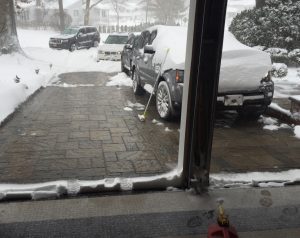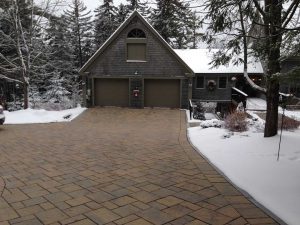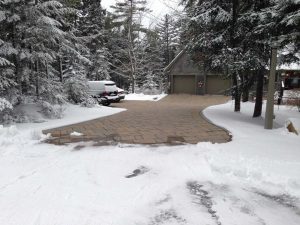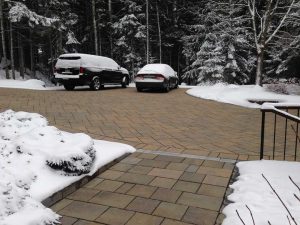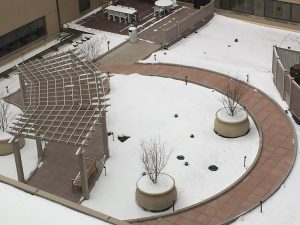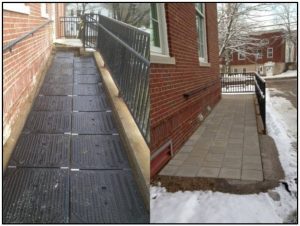Hardscape installers are not usually tasked with the installation of hydronic or electric cable pavement heating systems. However, they do need to be involved with the scheduling of the trades that do install these systems and quite often work hand in hand with the mechanical or electrical contractor to allow for a clean and seamless installation.
The most important step is to decide what the customer requirements will be for a safe, comfortable, year-round use of the paved areas. It is common to only think about whether they should snowmelt the surface and if so, how. What also needs to be considered is how the hardscape can be managed for safety, comfort, ecological, and economical use year-round.
Thanks to new Therma-HEXX product technologies, the customer has the option to heat and cool the paver surface whether it is a pedestal or ground-mounted paver installation. The paver mass can act as an invisible thermal solar collector that can heat a swimming pool or domestic water while cooling the paver surface in the warm months and snowmelt the surface in the winter months.
- Hydronic heating and cooling systems include:
- PEX, PE-RT, and Rubber tube radiant snowmelting of cast-in-place concrete pavements.
- ThermaPANEL modular heat exchange system for heating and cooling of all pavements including cast in place concrete, pavers, stone or architectural slabs whether pedestal, ground, deck, or grate mounted.
- Electric resistance cable
- Single strand cable
- Pre-configured cable mats
- For small ground-mounted installations of pavers or cast-in-place concrete or asphalt.
Hydronic Tube Systems
One of the most common snowmelt systems has been tubing embedded in a concrete slab (preferably insulated) that is connected to a heat source (boiler, geothermal) and a pump with a manual or automatic control that circulates a glycol water mixture throughout the system. This type of system has had less than perfect results when used with segmented paving due to installation requirements and can create cracked or spalling surfaces in poured concrete slabs due to uneven heating between the tubes.
In order for the tubing to stay in place during installation, the paving contractor must provide a wire mesh or re-bar grid laid out over the prepared structural sub-base. The mechanical contractor then ties the tubing to the grid with wire or plastic ties in a pre-engineered pattern; pressure tests it and then releases the site back to the paver installer to lay the bedding sand and pavers. The problem arises when the tube is tied to the re-bar totaling 1.5-2” of thickness with no room for bedding sand above the tube. When the pavers are set and compacted they want to settle between the tubes and re-bar. This creates a very weak and undulating paver surface over time resulting in endless callbacks to the hardscape installer and potential failure of the tubing. The tubing quite often is also not installed as specified by the engineer causing further uneven heating.
Each loop is connected to a nearby manifold that controls balanced flow to all of the rows within the system. The manifold(s) can be located in the mechanical room or in a sprinkler valve box. They need to be accessible.
Tube systems are usually designed by the tubing supplier or the installing contractor. Installers may or may not be manufacturer trained.
Electric Cable Systems
Electric cable systems are practical for smaller areas where the first installed cost is a factor and where a hydronic system is not feasible. The operating cost will be higher due to the higher cost of electrical energy in most regions versus gas or oil. An adequate electrical service must also be calculated into the installation. The hardscape installer must coordinate the installation with the electrician.
Electric cable systems must be tied to a metal or fiberglass mesh grid. It is then tested by the electrician. The site is then released back to the hardscape installer. The hardscape installer must be very careful not to nick or cut the cables when applying the bedding sand. Some manufacturers recommend up to 1 ½” of bedding sand over the cables, which is at the maximum limit allowed by ICPI guidelines (International Concrete Paver Institute). Most paver manufacturers recommend 1” of bedding sand to reduce the chance of settling. Pavers over 2.5” thick are not recommended with this system due to the limited Btu output. Once the pavers are placed, the system is re-tested by the electrician.
The cable system is usually designed by the electrician or with the help of the cable manufacturer.
Modular Panel Systems
Pedestal Mounted Pavers and Stones
Pedestal mounted pavers require a modular type of heat exchange system that is insulated on the bottom side with flexible fusion-welded connections between the units. The only commercially available system of this type is ThermaPANEL by Therma-HEXX.
The ThermaPANEL system is a hydronic modular array of panels that are 23.5” x 23.5” x 1.4”. The panel itself is only .4” thick with 1” of 12, 60, or 100 psi density EPS foam attached to the underside of the panel. They are factory assembled in rows from 2’- 48’ long using fusion welded connections. The panels can be set at 23.5” – 26” on center. A trimmable panel option is available that can be easily trimmed to fit in one direction by the installer using a jigsaw or circular saw. An 11.5″ x 23.5″ x 1.4″ panel is available for special narrow areas and steps.
The manufacturer’s engineers collaborate with the architect and installation contractors to provide a comprehensive design. The panel, tube interconnects; supply and return pipes, manifolds, and mechanical system design are provided in a clear set of plans for the installing contractors. Therma-HEXX provides an onsite instructor to train and certify first-time mechanical and hardscape contractors. Therma-HEXX also provides the necessary coordination between the general, hardscape, and mechanical contractors as well as the architect and paver supplier.
With pedestal installations, it is important that the correct size and type pavers are specified.
Pavers that are designed to be set on a 24” grid are 23 7/8” square. This allows for a 1/8” spacer on the pedestal which allows for drainage between the pavers. Some manufacturers call their pavers 24” when they are actually 23.5” or 600mm. These would be set on a 23 5/8” grid. Porcelain pavers that are manufactured in Europe are 600mm.
ThermaPANEL units are designed to rest directly on the pedestal adding only 3/8” to the height of the pedestal before the paver is set on top of the panel unit. The rigid insulation is cut away at the corners to allow the insulation to be located below the top of the pedestal. A ½” PE-RT tube in the shape of an S connects each panel to the next panel using a factory fusion-welded connection and is channeled within the 1” insulation. The S tube allows the panels which are connected into rows up to 48’ long to be folded up and packed into 7’ x 2’ x 2’ boxes for delivery to the job site. Each panel is permanently labeled with its section, zone, and row number for easy installation and maintenance.
Each row is connected to a nearby manifold that controls balanced flow to all of the rows within the system. The manifold(s) can be placed beneath the pavers or in a cabinet built into the parapet or wall. They need to be accessible.
Ground, Deck or Grate Mounted Pavers, Bricks, Stones or Artificial Turf
Ground-mounted installations are required to have an ICPI approved sub-base, with a thin ¼” layer of sand on top of the base to fill any voids in the rough base material. The 1.4” thick ThermaPANEL units come in bundles with 1” thick 60 psi or 100 psi density EPS foam insulation mounted to the back of the panels that get laid out at one end and are simply unfolded into place, hooked up to the pre-installed and tested manifold row by row until the entire zone is connected and pressure tested. Then the hardscape installer applies the ½ – 1” bedding sand, pre-tamps sand into any voids or spaces, and then screeds the area to the correct depth. Pavers are then set and compacted as usual.
The ThermaPANEL system provides structure to the base and adds full support to the paver array. It is advisable to pre-compact the sand into the joints and crevices between the panels. This can be done using a vibraplate with a plastic base or a hand tamp.
When using a grate-type support system such as Pierdex or Silca System mounted on a wood-framed deck or pedestals, any type or size of paver, brick, or stone can be applied over the system.
Wood-framed decks can also be configured to support the ThermaPANEL units with just the framing and then wood, PVC, or another synthetic decking can be applied over the panels and fastened to the framing located between the panels.
The ThermaPANEL system can also be applied beneath artificial turf for all of the same reasons as pavements, solar energy collection, cooling of the surface, and snowmelting.

